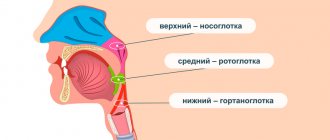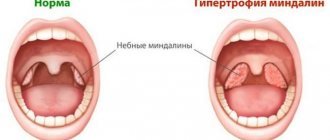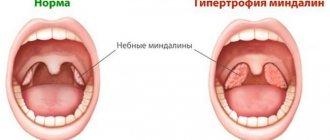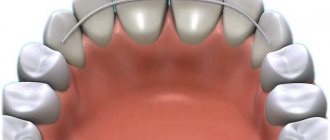Many parents have encountered the problem of a red throat in their child, which in most cases indicates inflammation. In this regard, it is very important to correctly determine the cause that caused the pathological process, since the effectiveness and success of treatment directly depends on this. And the first thing the otolaryngologist has to find out is: what is the nature of the disease - viral or bacterial?
We will tell Kaliningraders about all the nuances of the problem: the causes of throat hyperemia, possible diseases, and also how to distinguish a virus from a bacterial infection.
How can you tell if your baby has a sore throat?
First of all, it is necessary to examine the mucous membrane of the larynx. Hyperemia (redness) of the throat is an obvious, but not the only symptom. In addition, other clinical manifestations of inflammation may be present, such as:
- swelling of the tonsils and the presence of plaque on them;
- difficulty and pain when swallowing;
- redness of the visible parts of the throat;
- hoarse voice and sore throat;
- dry, barking cough;
- nasal discharge and nasal congestion;
- enlargement of the submandibular lymph nodes;
- loss of appetite and general weakness;
- headache and fever.
If some of the above symptoms occur, then parents should contact an otolaryngologist to find out the true cause of the inflammation. With adequate treatment, the prognosis is usually favorable.
Sinusitis.
Symptoms How to distinguish it from a simple runny nose? Why is it dangerous? What will happen if left untreated? How to treat? Prevention. Causes of occurrence.
Sinusitis is an inflammation of the mucous membrane of the maxillary sinus, which communicates with the nasal cavity. Sinusitis can be acute or chronic.
Acute sinusitis most often develops as a complication of acute rhinitis (runny nose), after infectious diseases, and also as a result of inflammatory diseases of the teeth (odontogenic sinusitis). Hypothermia may be a provoking factor due to a decrease in the body's defenses. Sinusitis differs from rhinitis (runny nose): the duration of the disease - a runny nose lasts 6-8 days, and sinusitis - up to 1 month, the presence of purulent discharge, pain in the area of the affected sinus.
Chronic sinusitis is usually a consequence of the transition of acute inflammation to a chronic form. This can be facilitated by thickening of the nasal mucosa, thickening of the nasal turbinates, curvature of the nasal septum, closing or narrowing of the outlet of the maxillary sinuses, and insufficient treatment of acute sinusitis.
Acute sinusitis is characterized by symptoms of general intoxication: chills, increased body temperature, poor general health, headache of varying intensity. In addition to general symptoms, local symptoms are observed: pain in the cheek area. The nature of the pain is intense and constant, accompanied by a feeling of fullness, intensified by tilting the head, coughing and sneezing. Photophobia and lacrimation are sometimes observed. The nose is stuffy, there is copious mucous discharge (catarrhal sinusitis), mucopurulent, purulent discharge (purulent sinusitis). On the side of the affected sinus, the sense of smell may be reduced. When the periosteum is involved in the process, swelling of the cheek and swelling of the lower eyelid are noted.
Chronic sinusitis is characterized by general weakness, malaise, fatigue, headache (usually in the evening), nasal congestion, and discharge. The sense of smell may be reduced. Vasomotor and allergic sinusitis is characterized by an undulating course with periodic remissions. The clinical picture of exacerbation is characterized by the same symptoms as in acute sinusitis.
Treatment is prescribed by an otolaryngologist. As a rule, treatment is carried out on an outpatient basis and consists of a course of pharmacotherapy: antibiotics, vasoconstrictor drugs, and decongestants are prescribed. At the final stage, the doctor may prescribe physiotherapeutic procedures.
In case of odontogenic sinusitis, treatment by a dentist is also required.
In severe cases and the presence of complications, hospitalization is indicated.
Treatment of sinusitis is mandatory, because this disease can cause serious intracranial, intraorbital and bronchopulmonary complications: swelling of the meninges, meningitis, swelling of the tissue of the orbits and eyelids, bronchitis, pneumonia and other complications.
What makes your throat red?
In 80% of cases, the cause of redness of the throat is viruses and bacteria, less often fungal infections. However, it makes sense to voice non-inflammatory causes. These include:
- mechanical microtrauma of the mucous membrane;
- eating hot or coloring foods;
- contact with allergens or smoke;
- prolonged vocal load.
Without a doubt, chronic diseases of the nose and nasopharynx contribute to the spread of infection when inflammation spreads to the throat (the so-called “postnasal drip”). In such cases, it is important to promptly treat rhinitis and sinusitis, preventing the diseases from becoming chronic or protracted.
How to distinguish a viral infection from a bacterial one?
Let's start with the fact that bacterial infection is much less common than viral infection. In such cases, the disease is more complicated than a regular ARVI, and lasts from 5 to 14 days. Typical signs of bacterial attachment include:
- high body temperature;
- swollen lymph nodes;
- thick yellow-green sputum produced when coughing;
- the appearance of white plaque on the pharyngeal tonsils;
- clinical symptoms are expressed locally (ear, throat or nose).
The virus is characterized by:
- hyperemia of the throat is combined with sore throat and runny nose;
- expectorated sputum is clear and flowing;
- the appearance of a rash (with measles, rubella and scarlet fever);
- general weakness and aches throughout the body.
There are also significant differences regarding the treatment regimen. If the inflammation is bacterial in nature, antibiotics are indicated; only they can solve the problem. Accordingly, with viruses, antibacterial drugs will be useless; in such cases, it is necessary to take antiviral drugs. Therefore, it is very important to consult a doctor who will identify the true cause of the red throat and prescribe the right solution.
How to treat a sore throat in a child?
An infection of a child's tonsils is called tonsillitis. The tonsils are glands in the back of the throat. Tonsils are part of the immune system and help fight germs in the mouth. Tonsils often become infected with viruses or bacteria. Bacterial tonsillitis is sometimes called tonsillitis (including streptococcal tonsillitis). Tonsillitis is common in children of all ages and often occurs with colds, runny nose and cough. Even if tonsillitis is caused by bacteria (tonsillitis), it is usually an infection that the child can recover from without antibiotics. Antibiotics do not improve tonsillitis symptoms, and most children have a sore throat that persists for three to four days, even if they are treated with antibiotics. Waiting to see if children get better without antibiotics is helpful because it increases immunity to infection and reduces the chance that your child will get tonsillitis again from this type of infection. If your child has recurring infections, it may be helpful to change the toothbrush after each infection to prevent the tonsils from becoming infected again.
Antibiotics are used for infection of the tonsils with Beta-hemolytic streptococcus group A (GABHS). However, the use of antibiotics in this case is aimed at preventing severe complications, such as rheumatic damage to the heart or joints.
Signs and symptoms of tonsillitis (tonsillitis)
If your child develops tonsillitis, it may present with the following symptoms:
- A sore throat
- Difficulty swallowing
- Painful lymph nodes (glands under the jaw)
- Ear pain (middle ear infection must be ruled out)
- Fever
- Bad breath
- Loss of appetite
- Lethargy and general malaise.
- Older children may also complain of headaches or stomach pain.
When to see a doctor?
If you think your child has developed tonsillitis for the first time, take him to a pediatrician, general practitioner, or ENT doctor. If your child has had tonsillitis before and it usually improves with home care, you don't always need to see a doctor.
Because tonsillitis is often caused by a virus, your doctor may not prescribe antibiotics because they will not help your child.
But some children may need antibiotics, including:
- those who have previously suffered from rheumatic heart disease,
- children with severe tonsillitis, especially if there is a rash (called scarlet fever)
- children who have complications, such as an abscess behind the tonsil or in the lymph nodes of the neck.
If swallowing is difficult, some children are given prednisolone (an anti-inflammatory corticosteroid drug) with or instead of antibiotics. Prednisolone reduces swelling of the tonsils.
If your child feels very unwell, is drooling and has difficulty breathing, call an ambulance immediately. This could mean dangerous inflammation of the epiglottis.
Caring for a child with a sore throat at home
Most children with tonsillitis can be treated at home after visiting a doctor (if necessary).
You can care for your child in the following ways:
- Make sure he gets plenty of rest.
- Give him a pain reliever, such as paracetamol or ibuprofen.
- Give your child more fluids to drink. This will prevent dehydration and make your throat less dry and sore. Ice cream is a good option as it provides extra fluid while also soothing inflammation and reducing sore throats.
- There are no restrictions on what a child can eat or drink. However, children may prefer softer foods if they have a sore throat.
- The child should stay at home until his fever has passed and he can swallow again without pain or difficulty. This usually takes three to four days.
If your child is prescribed antibiotics, give them to your child as directed and make sure the full course of antibiotics is completed.
You should call your doctor if your child has tonsillitis or sore throat and:
- Difficulty breathing with increased snoring during sleep
- Difficulty swallowing and signs of dehydration
- The child has difficulty opening his mouth
- You are worried for any other reason.
How to prevent tonsillitis from spreading to other children in the family?
Maintaining good hygiene reduces the chance of transmitting infection to others. Good hygiene includes: regularly washing your hands thoroughly, not sharing cups or cutlery, not allowing toothbrushes to touch, encouraging children to cough or sneeze into their elbow and using disposable tissues instead of handkerchiefs. Teach your child to throw tissues in the trash as soon as they are used and to wash their hands afterwards.
Key Points to Remember
Tonsillitis is an infection of the tonsils that can be caused by viruses or bacteria.
Bacterial tonsillitis is called tonsillitis.
The most dangerous form of sore throat is GABHS sore throat. It requires the use of antibiotics.
Most children recover with rest at home, pain relief, and plenty of fluids.
Many children do not need antibiotic treatment. Antibiotics do not treat viruses.
If antibiotics are prescribed, be sure to complete the course of antibiotics.
Diagnostic methods
Diagnostics consists of examining the patient, collecting anamnesis and a comprehensive examination, including:
- pharyngoscopy - visual examination of the pharynx;
- mirror laryngoscopy – examination of the larynx using a laryngeal mirror;
- endoscopic method - examination of the larynx using an endoscope;
- clinical blood test;
- bacteriological method (culture of mucus from the oropharynx will help determine the causative agent of the disease).
When examining a small patient, the doctor assesses:
- general view of the mouth, throat and larynx;
- color of mucous membranes and presence of swelling;
- size and color of tonsils;
- condition of the submandibular lymph nodes.
As soon as the causative agent of the disease is known (virus, bacteria, fungus or allergen), the doctor will prescribe appropriate treatment. If necessary, the otolaryngologist will refer the child to a specialized specialist.
Methods for treating throat diseases
Therapeutic measures, as in the treatment of any other diseases, involve solving two main problems:
- Elimination of intoxication and local syndromes.
- Prevention of the development of complications from other organs and systems.
As a rule, when treating red throat, drug treatment is used, taking into account the age of the child and the severity of the pathology. Depending on the etiology of the identified disease, the following drugs can be used:
- antiviral;
- antibacterial;
- antifungal;
- antiseptic;
- antihistamines;
- antipyretics and painkillers;
- immunomodulators and vitamins.
Treatment can be effectively complemented by physiotherapy: UV and UHF therapy, quartz, electrophoresis. Note that in 90% of cases, infectious diseases of the upper respiratory tract have a viral etiology, so antibiotic therapy is indicated only if a bacterial infection is detected. Only a doctor can determine it. We remind parents once again that it is categorically unacceptable to prescribe antibiotics on their own.
How to quickly cure a throat?
A sore throat may be accompanied by other sensations, depending on the cause and severity of inflammation of the back wall of the pharynx and tonsils. A person may experience chills, runny nose, hoarseness, difficulty breathing, general malaise, and headache.
In order to quickly overcome the disease, you need to accurately determine the cause of the inflammation. Only a doctor can deal with the problem and find the most effective solution. Therefore, if you have a sore throat, you should definitely make an appointment with an ENT specialist.
Recovery criteria
The following signs indicate successful treatment and speedy recovery:
- normalization of temperature;
- absence of signs of intoxication and asthenic syndrome;
- redness and swelling of the oropharynx disappeared;
- the size of the lymph nodes decreased.
Note that it is equally important during the treatment process to strictly follow medical recommendations, which consist of following bed rest, a gentle diet and drinking plenty of fluids.
We remind Kaliningrad residents that you can make an appointment with a pediatric otolaryngologist by filling out a preliminary application on our website or by calling: +7 (4012) 357-773 or +7 (4012) 973-100.











